As the title states, this is a
1/72 model comparison of two German light towing tractors of the WW2
period [however with no discussion of ESCI’s Pak 40 towed antitank
gun included in the ESCI kit and part of at least one other ESCI model
kit]. The ESCI kit has been re-released by the Italeri model company
as Kit #7016. I did not measure the kits for exact scale but they
appear reasonably close to 1/72 scale, and larger than Matchbox’s
1/76 scale Sd.Kfz. 11 halftrack model.
Vehicle History For The Modeler
Though I do not see this vehicle modeled often at shows and at internet
sites, it was one of the more important and common German softskin
vehicles of WW2, serving from before 1938 till 1945, on all war fronts.
Its chassis and suspension was the basis for the Sd. Kfz. 251 armored
personnel carrier halftrack. The Sd. Kfz. 11 was produced not only
in Germany but also in Czechoslovakia and Hungary. [A photo I have
claiming to be a Hungarian produced version shows a hard square cab
similar to the Modell Trans kit but with the sheetmetal rear of the
ESCI version, and it tows a Hungarian produced 4-cm Bofors AA gun.]
Approximately 8800 of the Sd. Kfz. 11 halftrack were produced.
Variants include the Sd.Kfz. 11 artillery towing tractor, the Sd.Kfz.
11/2 decontamination and detoxifying vehicle, and the Sd.Kfz. 11/1
and Sd.Kfz. 11/4 fog/smoke-laying launcher prime mover (actually towing
vehicles for the Nebelwerfer & rocket launcher towing vehicles).
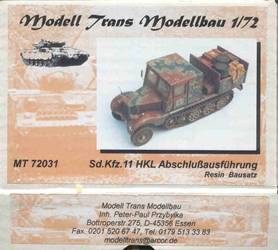
Above is Modell Trans Modellbau box that came with my model with a
photo of the completed model, to be more accurate: a photo of Master
Modeler Tony Greenland’s 1/35 scale model from Azimut Models,
not this 1/72 scale model, but more on this below. The photo shows
a hard cab with a storage compartment behind the driver’s seat.
Behind the cab is a bench seat for about two or three soldiers, then
a small wood cargo bed in the back full of drums and boxes. I have
seen only one photo of this vehicle below which is finished in plain
Panzer Yellow (Dunkelgelb) color.
From reference book Panzer Tracts No.22-2 this version of the Sd.Kfz.11
halftrack is a variant of the Sd.Kfz.11/3 medium poison gas applicator/sprayer
vehicle model 39 (mittler Sprühkraftwagen (Bauart 39)). It appears
that the poison gas (more likely a liquid nerve agent) storage tank
was removed from the rear bed and replaced by a small cargo bed.
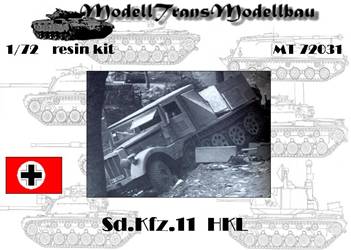
Above is the new box cover for the Modell Trans SdKfz
11/3 HKL kit that Modell Trans Modellbau sent to me for this review.
The new box art no longer shows a photo of Tony Greenland’s
1/35-scale model but a WW2 era photo of the Sd.Kfz 11/3.
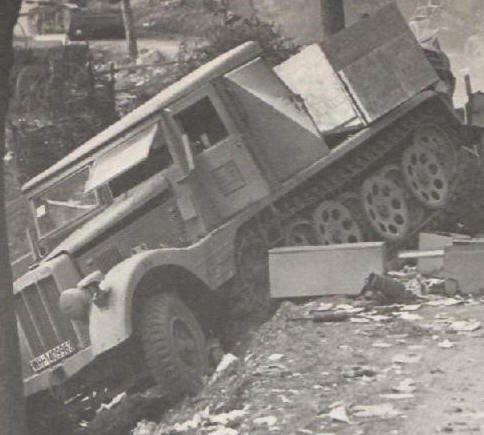
The inspiration for the Modell Trans Modellbau kit? Notice the shipping
information stencil on the driver’s door. The windshield is
two panes with one pane open; a little simplified from the typical
SdKfz. 11 windshield on the ESCI/Italeri model.
The license plate beginning with WH shows this to be a Heer (Army)
vehicle; the whole number appears to be WH-1409963. A Sherman tank
to the right, cropped out of this photo, indicates that this photo
is from the Western European front. Below the turn signal and next
to the engine compartment there appears to be a small flap open, perhaps
for ventilation.
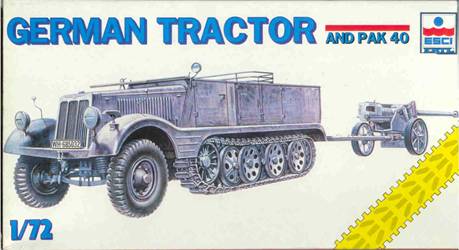
The box art for ESCI’s kit shows what looks to me to be a Sd.Kfz.11
with the standard artillery body towing a Pak 40 antitank gun. (It’s
interesting in that the drawing of the ESCI Pak 40 is in recoil position
like the model is mistakenly in (in my opinion.) The windshield is
folded down; behind the driver’s seat is a storage rack atop
the ammunition storage compartment. Behind the ammunition compartment
is the crew seating area. The vehicle is painted in panzer gray color.
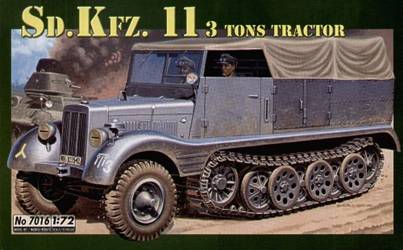
Italeri’s re-release of the ESCI kit shows the vehicle with
the windshield raised and the canvas cover raised, opened up. The
twin ammunition compartment doors behind the driver are clear. This
version typically towed guns like the Pak 40 and Pak 41 antitank guns,
the 105-mm leFH18 howitzer, 40-mm and 50-mm AA guns and the 155-mm
sIG 33 Infantry Gun. (Nebelwerfer rocket launchers were supposed to
be towed by the Sd.Kfz.11/2 and Sd.Kfz.11/4 variants of this halftrack.)
Kit Comparison
ESCI / Italeri
This old ESCI kit has been released by Italeri however without the
Pak 40 AT gun I understand. The ESCI kit depicts the original medium
artillery towing tractor with the sheetmetal body, ammunition storage
compartment in the middle, and seating for six gun crewmen in the
rear. The model has about 75 gray colored injection-molded styrene
plastic parts, not including the link & length styrene tracks
which have about 45 parts. The Italeri release and some ESCI kits
have the link & length tracks; some old ESCI kits offered the
ghastly stiff polyethylene band tracks.
The molding is very good and though I haven’t assembled it yet,
so I can’t say much about fit, I consider this one of ESCI’s
better kits for detail. An exception to this is the seat cushion texture:
a bit coarse that should be smoothed down.
Though I believe it should have the same roadwheels as the Sd. Kfz.
251 armored halftrack this halftrack model comes with slightly different
roadwheels than the ESCI 251 halftrack model. This strikes me as extra
work for ESCI in engineering the molds, so go figure. Overall the
suspension looks like it’s cast pretty well.
The underside is well detailed (and as the Modell Trans kit appears
based on the ESCI kit the same goes for their model also).
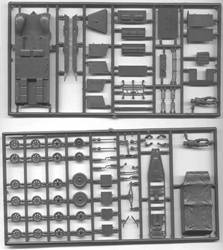
Two sprue make up the ESCI/Italeri Sd.Kfz.11 model body and suspension.
At upper left is the one-piece bed/floor with the seats. The drivers
and crew’s seats have a course pebbly surface that I recommend
you sand smooth. Two reasonably nice seated crew figures are included.
The driver’s doors are molded shut but should not be hard to
cut open. The ammunition compartment doors can be molded open or closed.
At bottom right is the optional canvas cover molded with decent realism.
The storage area frame (parts 45,46 and 47) are a little too thick.
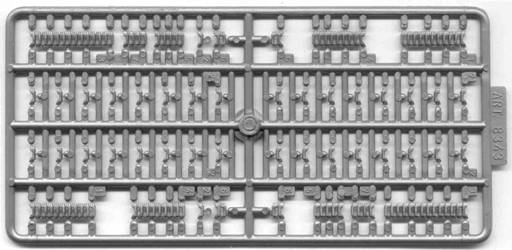
These are ESCI’s hard styrene
injection-molded tracks for their Sd.Kfz.11 and Sd.Kfz.251 models.
The tracks have decent detail on the exterior surface but lack track
teeth and hinge details.
Model Trans
The Modell Trans Sd.Kfz. 11 depicts one of the late-war variants with
a simplified cab and pressed paperboard and wood cab and bed. I have
not found a lot of information on this version but I believe this
is a modified version of the Sd.Kfz.11/3 medium poison gas applicator/sprayer
vehicle model 39. As seen in the scans, the kit comes with fewer parts
than the ESCI kit (about 24 total parts) but appears definitely based
on the ESCI plastic kit.
As we see in the scan of the parts, the suspension (wheels & tracks)
is mostly cast as a one-piece unit (a left and right side), except
for the outer roadwheels which are separate. This casting & assembly
method impress me as an ideal compromise between totally individual
wheels and tracks, and the entirely one-piece unit common of wargaming
pieces. A plus for Modell Trans is that they added track teeth to
the track interior surface.
Like in Azimut’s 1/35 scale model built by Tony Greenland, Model
Trans’ kit comes with nicely done boxes and two fuel drums for
the cargo bed (just like what is in the Azimut kit !). No figures
are included.
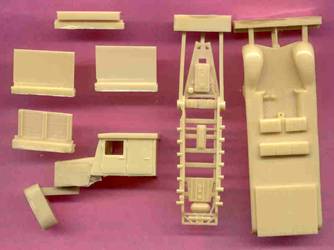
Not all the Modell Trans parts are shown here. Through the magic of
resin casting Modell Trans casts a nicely detailed model in fewer
parts. The cab is molded as one piece with the engine compartment.
No clear plastic is included to make the windshields. Separating the
parts from the pore plugs does not appear difficult.
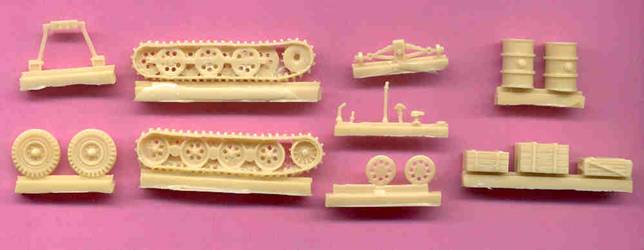
Despite being molded mostly as one piece suspension and tracks, with
just the outer wheels to install, I found the tracks and wheels to
look very well done. Parts are molded crisp and clean.
Instructions
Model Trans
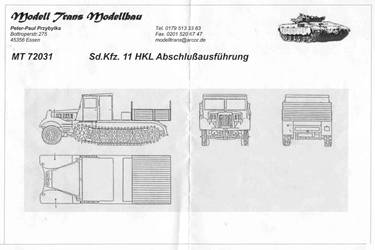
On examining the Modell Trans instructions we notice that they consist
of a very nice four-view line drawing of the vehicle but no parts
list or typical exploded-view drawing common to most resin, metal
or plastic model kits. If we are familiar with the vehicle and with
assembling resin kits, this lack of clear instructions should not
hinder us much. Fortunately the suspension is essentially already
put together. Still, good instructions would be nice and may preclude
this model from beginner modelers. ESCI/Italeri’s Sd.Kfz.11
kit assembly instructions should help.
ESCI / ITALERI
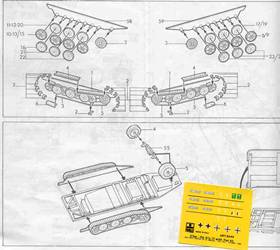
The ESCI instructions are the typical,
step by step exploded-view drawings showing pretty complete assembly
instructions. Parts are numbered. Arrows show where the parts connect.
Like with all kits, study and dry fit the parts before assembly and
gluing. The canvas cover (part 1) can be left off if desired. The
link & length tracks can be difficult to assemble straight. I
recommend assembling the wheels and track links before attaching the
bottom frame to the upper body, like the kit instructions advise.
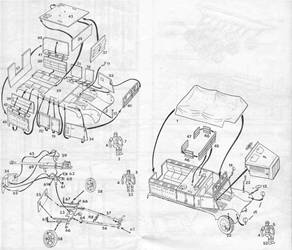
Markings & Painting
The ESCI/Italeri model comes with water-slide decal markings for three
German vehicles. The decals include two sets of German crosses though
I have found the crosses very rare on softskins. Extra license plates
will be used on my Model Trans kit. Being used from 1938 till 1945,
the ESCI version may be panzer gray, Afrika tan or panzer yellow with
brown and/or green camouflage patterns.
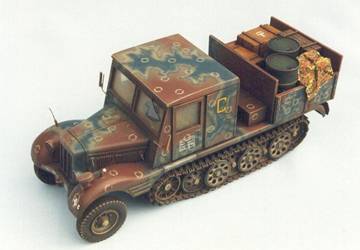 
Tony Greenland’s 1/35 scale model photo from book (left) and
Modell Trans box photo (right).
The Modell Trans kit includes no markings (though the box art has
a unit marking on the fender and a transport stencil on the door).
While the original Sd.Kfz. 11/3 was painted in pre-1943 dark gray,
Modell Trans’ version of the 3-ton tractor should most likely
be just plain panzer yellow in my opinion, but a multi-color camouflage
pattern is certainly possible. I believe that Tony Greenland’s
ambush scheme camouflage seems highly unlikely to me as the ambush
scheme was more labor intensive and I understand it was primarily
meant for AFV’s that were in need of hiding from foes nearby.
Conclusions
Both kits are well detailed and accurate 1/72 scale models. If it
were not for the poor assembly directions, Modell Trans would be more
suitable for novice builders. Both kits would make superb display
models or wargaming pieces (assuming fit and assembly goes well).
Either model can be modified to one of a number of variations such
as a straight wooden cargo bed.
References
- German Light Half-Tracked Prime Movers, 1934-1945,
by Reinhard Frank, Schiffer Publishing Ltd. (1997). A great, inexpensive
softcover book covering the 1-ton Sd.Kfz. 10 and the 3-ton Sd.Kfz.
11 halftracks with period photos and historical information.
- Panzer Tracts No.22-2, Leichter Zugkraftwagen 3
t (Sd.Kfz.11) and Variants, Thomas Jentz and Hilary Doyle (2009).
Softcover book with 84 pages of in-depth information, photos and
line drawings.
- Tony Greenland’s PANZER MODELING MASTERCLASS,
Windrow & Greene Publishing (1995). An excellent hardcover book
on constructing and weathering German WW2 models in 1/35. The book
included several photos of the Sd.Kfz.11/3 featured by the Model
Trans company.
- http://ipmslondon.tripod.com/armourreferencearticles/id31.html
London IPMS website with Reference photos of the late version of
the Sd.Kfz. 11 halftrack.
- http://www.panzer-modell.de/referenz/in_detail/sdKfz.11/sdKfz.11.htm
German website with good detail reference photos.
|